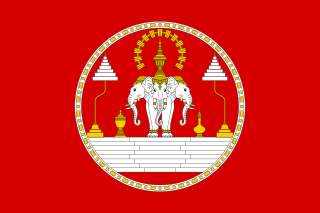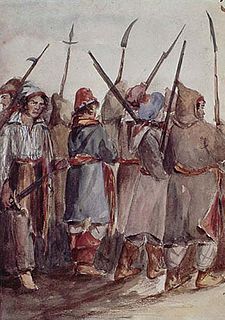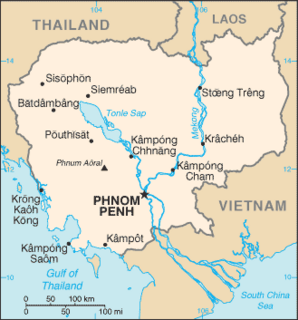The Battle of Luang Namtha, fought between January 1962 and May 1962, was an important engagement of the Laotian Civil War. It came about as a result of the turmoil following Laotian independence as a result of the First Indochina War with France. The Kingdom of Laos had foreign soldiers upon its soil, and a political struggle in progress concerning those outside troops. Following a coup and counter-coup that left General Phoumi Nosavan in charge, the general decided on military action to settle the political issue of interlopers in Laos.
The Battle of Lak Sao, fought between November 1963 and January 1964, was a major engagement of the Laotian Civil War. In November 1963, General Phoumi Nosavan, who held the reins of military power in the Kingdom of Laos, launched a military offensive against North Vietnamese invaders that cut across the northern panhandle of the nation. Although unsupported in this proxy action by his backers in the U.S. Embassy, he went ahead with his plan to push northwards from Nhommarath, then veer eastwards to the Vietnamese border. Phoumi's Central Intelligence Agency (CIA) advisors warned him that the North Vietnamese would retaliate, but he disregarded them.
Operation Diamond Arrow was a battle in southern Laos, waged from 20 September 1969 through 9 March 1970. The struggle centered on a Royal Lao Army stronghold at the strategic road intersection of Routes 16 and 23. Due to intervention by U.S. and Lao tactical air strikes, and an air bridge supply effort, the Royal Lao Army troops survived besiegement in a fixed defensive position, only to abandon their position post-battle.
Kou Kiet was a major Laotian Civil War victory for the anti-communist troops of the Kingdom of Laos. Patterned after prior Operation Raindance, it depended upon extensive air strikes blasting communist units and clearing them from the path of the Royalist offensive. Powered by 150 daylight and 50 night sorties daily, with 50 to 80 day strikes directed by Raven Forward Air Controllers, Kou Kiet ran from 6 August to 30 September 1969. It was successful beyond expectations. After the Royal Lao Government troops achieved their objectives, General Vang Pao insisted on pushing forward while they had the initiative. As a result, the Royalists regained control of the entire Plain of Jars while also capturing a huge stock of munitions from the communists. Their triumph came at a cost. However successful the Royalists were, by battle's end their battle-worn forces had exhausted their pool of potential recruits, while the Vietnamese could easily replace their personnel losses.
Operation Junction City Jr. was a major Laotian offensive of the Vietnam War; initially aimed at temporary disruption of the Ho Chi Minh Trail, it was extended into an attempt to isolate the major North Vietnamese communist transshipment point at Tchepone from the units it was supposed to supply.
Operation Left Jab was the first military offensive launched against the Sihanouk Trail extension of the Ho Chi Minh Trail during the Second Indochina War. It was the first battalion-sized operation waged by the Royal Lao Army against the communists. Carried out between 21 and 26 June 1969, the assault interdicted Route 110 of the Sihanouk Trail for its planned three-day stoppage of military supplies. The Royalist guerrillas of Special Guerrilla Unit 2 then evaded an approaching counterattack and regrouped in friendly territory. Operation Left Jab had cleared the way for Operation Diamond Arrow.
Operation Honorable Dragon was an offensive of the Second Indochina War. The Central Intelligence Agency, which equipped and trained the needed troops, aimed at disruption of the North Vietnamese communist supply line, the Ho Chi Minh Trail. Launched by six battalions of Royal Lao Army military irregulars on 31 August 1970, the operation achieved only limited success. Although the planned objective was captured on 25 September, the offensive was plagued by desertions and combat refusals, including a battalion that ran from "ghosts". After the conquest of Pakse Site 26, troops of the People's Army of Vietnam (PAVN) harassed the Lao occupiers through mid-December 1970.
Campaign 139 was a major military offensive of the People's Army of Vietnam, launched against its Royalist enemies during the Laotian Civil War. Larger than previous invading forces, Campaign 139 was also a combined arms expedition containing tanks, artillery, engineers, and Dac Cong sappers. As such, it was a decided escalation in the war. It was also an exceptional rainy season offensive by PAVN, which usually withdrew during the wet season.
The Tchepone Operation was an interdiction campaign by the Royal Lao Armed Forces aimed at disrupting the People's Army of Vietnam (PAVN) supply line, the Ho Chi Minh trail. The pair of three-battalion Central Intelligence Agency-sponsored Royalist irregulars aimed at a communist garrison at Moung Phine, and the vital transshipment point of Tchepone. The Muang Phine thrust was fruitless. The Tchepone column stalled on Route 9 only 13 kilometers from the logistics center on 31 October. Between 1 and 10 November, the PAVN fiercely attacked while reinforced with nine antiaircraft guns and six mortars. The Royalist guerrillas retreated to base under cover of tactical air strikes by the Royal Lao Air Force and U.S. Air Force that inflicted heavy casualties on the PAVN, including close air support delivered within 20 meters of the Royalists. Analysis of the results of the Tchepone Operation convinced the CIA that regimental operations should replace multi-battalion ones.
Operation Silver Buckle, an offensive staged in Military Region 4 of the Kingdom of Laos, was the deepest Royal Lao Armed Forces penetration to date of the Ho Chi Minh Trail. Reaching the Trailside village of Moung Nong, the forward two companies attacked the rear of the 50,000 People's Army of Vietnam (PAVN) garrison on 8 February 1971, just as Operation Lam Son 719 was launched by the Army of the Republic of Vietnam (ARVN). Overrun and scattered while suffering serious casualties, the Groupement Mobile 30 irregular regiment of Silver Buckle had tied up at least six PAVN battalions, preventing them from opposing Lam Son 719.
Operation Desert Rat was a diversionary attack by a Laotian irregular regiment upon the crucial communist supply line, the Ho Chi Minh trail. Carried out by the Central Intelligence Agency sponsored Groupement Mobile 33, the Desert Rat offensive struck the rear of the 50,000 North Vietnamese troops combating Operation Lam Son 719 beginning on 16 February 1971. With 16 daily tactical air sorties and airborne forward air controllers available, the Desert Rat guerrillas used their hilltop position near Moung Phine to spot targets for bombing. It also raided, skirmishing 110 times, killing 121 communist soldiers, and sowing 1,500 mines along North Vietnamese lines of communication. On 20 March, it was assaulted by two communist battalions. The major threat of Lam Son 719 ended, leaving the communists free to deal with the minor one of Desert Rat. However, the guerrillas split into three columns and exfiltrated by 3 April 1971. The Royal Lao Government had lost control of the strategic Bolovens Plateau to the communist invaders.
Operation Xieng Dong was a successful defensive strike by the Royal Lao Army (RLA) against an invasion by the People's Army of Vietnam (PAVN). In early February 1971, PAVN forces swept RLA defenders from a line of hilltop positions guarding the royal capital of Luang Prabang. The city's perceived invulnerability to attack was shattered. King Sisavang Vatthana refused to leave his capital. Other Military Regions of Laos hastily forwarded to Luang Prabang's Military Region 1 any troops that could be spared from the rest of the Laotian Civil War. On 7 April, the resulting patchwork force of RLA battalions, Forces Armee Neutraliste half regiment, and Central Intelligence Agency-backed Special Guerrilla Units managed a three-pronged offensive supported by tactical aviation that surrounded and defeated the invading PAVN 335th Independent Regiment, which had gotten within eight kilometers of Luang Prabang. By 5 June 1971, the 335th was in full retreat.
Operation Sayasila was a major offensive military operation of the Laotian Civil War. It was staged by command of King Sisavang Vatthana. Launched on 26 July 1971 against the Ho Chi Minh Trail complex and its People's Army of Vietnam (PAVN) garrison, Sayasila was planned as a rather complex two phase operation dependent on coordinating two columns containing 4,400 troops with close air support in an attack on 1,100 Vietnamese Communist soldiers. When the assault stalled in mid-August, it was elaborated upon with two additional helilifts of Royalist troops behind the PAVN's mobile garrison. When the Royalist command failed to coordinate tactical movements among its various columns, the PAVN 9th Regiment moved to defeat Royalist aggressor columns one at a time. By 1 September, this Royalist attack had also failed.
Operation Thao La was a Royal Lao Government (RLG) dry season offensive during the Laotian Civil War, aimed at severing the Ho Chi Minh Trail and retrieving the Lao Bolaven Plateau from the grip of the People's Army of Vietnam. Its objectives were the use of recently captured Salavan as a jumpoff point for occupying Tha Theng and Ban Phong. Key to the plan was a prearranged daily allotment of supportive tactical air power.
Operation Sinsay was a Royal Lao Government offensive of the Laotian Civil War. The planned offensive was pre-empted by prior moves by the opposing People's Army of Vietnam (PAVN); they struck on 6 March 1972. Although the Communist attack reached Laongam, 21 kilometers from Pakxe and the Thai border, and the defending Royalist battalions there were reassigned to fight in Operation Strength on the Plain of Jars, monarchist guerrillas were able to interdict Communist supply lines and force a Vietnamese retreat by the end of March 1972.
Operation Fa Ngum was a Laotian military offensive aimed at capturing the villages of Ban Ngik and Laongam as bases for incursions onto the Ho Chi Minh Trail. The Central Intelligence Agency backers of Royalist guerrillas planned to use a combination of air mobility and route march assaults to clear Route 23 through the two towns. Defensive forces to be defeated were the People's Army of Vietnam 9th and 39th Regiments. At various times and in differing combinations, the Royalists would commit two regiments of guerrillas, a makeshift regiment of the Royal Lao Army, three battalions of Neutralists, and a detachment of armored cars. Fighting a two-phase battle, the Royalists displaced the two PAVN regiments back towards the Vietnamese border. The Royalists both gained and gave up the open air cemetery of Ban Ngik. The PAVN returned westward toward the Thai border as the Royalists fell back. Enfeebled by mutiny and a serious casualty rate, the Royalists ended Operation Fa Ngum with a weak defensive blocking position at Laongam on Route 23.
Operation Black Lion was a Royal Lao Government counter-offensive against a People's Army of Vietnam thrust that cut the Kingdom of Laos in two at Khong Sedone during May 1972. Two regiments of Royalist military irregulars retaliated on 15 June 1972, attacking the Communist 39th Regiment in an air assault while Royal Lao Air Force tactical air strikes hammered the 39th. During the next month, the 39th Regiment would suffer an estimated 360 casualties and be rendered ineffective for attacks. On 18 July, they retreated, leaving a rear guard to be overrun.
Campaign 972 was the final offensive in the south of the Kingdom of Laos by the People's Army of Vietnam (PAVN). After fending off a score of Royal Lao Government attacks against the Ho Chi Minh Trail between June 1969 and late 1972, the PAVN attacked and essentially cut Laos in two at Khong Sedone by November 1972. Sporadic ongoing fighting, especially for control of Paksong, continued until 8 February 1973. Although a ceasefire officially ended the Laotian Civil War at noon on 23 February with Salavan, Thakhek, and Lao Ngam in Communist hands, the PAVN launched another successful assault on Paksong 15 minutes later.
Operation Black Lion V was the final Royal Lao Government offensive of the Laotian Civil War. Launched as a followup to Operation Black Lion and Operation Black Lion III, it too was aimed at regaining control of the Bolovens Plateau, which overlooked the Ho Chi Minh trail. This last assault took the town of Paksong on the plateau on 6 December 1972 and held it until a ceasefire took effect at midday on 22 February 1973. A People's Army of Vietnam attack began at 12:05 the same day and overran Paksong by dark.







